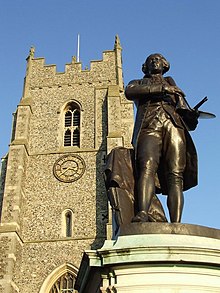Suffolk
| Suffolk county | ||
|---|---|---|
|
||
|
|
||
|
|
||
| Country | United Kingdom | |
| Part of the country | England | |
| region | East of England | |
|
|
||
| status | Ceremonial and Administrative County | |
| First mention | Early middle ages | |
|
|
||
| Ceremonial county | ||
|
|
||
| Administrative county | ||
| Administrative authority | Suffolk County Council | |
| Administrative headquarters | Ipswich | |
| ISO-3166-2 | GB-SFK | |
| surface | 3,801 km² | |
| Residents | 758.556 | |
| was standing | June 30, 2018 | |
| ONS code | 42 | |
| GSS code | E10000029 | |
| NUTS code | UKH14 | |
| Website | www.suffolk.gov.uk | |
|
|
||
Districts / Unitary Authorities
|
||
Suffolk [ ˈsʌfək ] is a county northeast of London on the east coast of England . Along with Cambridgeshire and Norfolk , this area of England is also called East Anglia . The county is bordered by Norfolk to the north, Cambridgeshire to the west and Essex to the south. The main town is Ipswich ; other important locations are Bury St Edmunds , Lowestoft and Stowmarket .
The name comes from south folk (the "southern people") of the angling - cf. Norfolk .
From 1889 to 1974 Suffolk was divided into two administrative counties , East Suffolk and West Suffolk . Since April 2019, Suffolk has been divided into five districts : Babergh , East Suffolk (developed from Suffolk Coastal and Waveney ), Ipswich , Mid Suffolk , West Suffolk (developed from Forest Heath and St Edmundsbury )
history
Before the conquest by the Romans settled here the Celtic Iceni , In Roman times ran along the coast of Suffolk, the fortress of the chain "litus saxonicum" ( Saxon Shore ), the u. a. should protect the River Deben from pirate incursions. Walton Castle also belonged to this chain . In the 5th century the Angles immigrated to the previously sparsely populated region. Sudbury and Ipswich developed into probably the most important settlements of the Anglo-Saxon period . The boat grave of Sutton Hoo , possibly that of King Rædwalds, dates from the 7th century . In Dommoc , which is mostly identified with today's Dunwich , there was a headquarters of the Kingdom of East Anglia and a diocese . In the 9th century there were repeated incursions by the Vikings , which devastated all of East Anglia in 869.
After the Norman conquest there were many moths or castles such as Eye Castle , Clare Castle , Denham Castle . Framlingham Castle and Walton Castle (the latter on the walls of the Roman fort). In the period that followed, wool processing developed, which became famous for the fine wool of the Suffolk sheep . Dunwich, which by the 13th century had developed into a flourishing port with many inhabitants through the wool trade, lost many inhabitants, many houses and its importance through storms and coastal demolitions in 1286, 1287, 1328, 1347 and 1362. The neighboring Walberswick was used as a harbor for this. The coastal erosion is still in progress. It was not until the Victorian period that new coastal towns such as Felixstowe and Lowestoft developed .
Although Suffolk was designated as an independent county in the Domesday Book 1086, it was administered jointly with Norfolk by a sheriff until 1575. In the Wars of the Roses it was mostly the York house . The borders of Suffolk have hardly changed since the Middle Ages, apart from coastal demolitions like the last one in 1953 and 2013.
Cities and towns
- Aldeburgh
- Beccles , Blundeston , Blythburgh , Bradenham , Bramford , Brandon , Broad Street , Bungay , Bury St Edmunds
- Capel St. Mary , Castling's Heath , Cavendish
- Ditchingham , Dunwich
- East Bergholt , Edwardstone , Eye
- Felixstowe , Framlingham
- Gosling Green , Groton
- Hadleigh , Halesworth , Haverhill , Herringfleet , Honington , Horner's Green , Hintlesham
- Ipswich
- Kesgrave , Kessingland , Kettlebaston
- Leiston , Lowestoft - Great Britain's easternmost city
- Mildenhall , Mill Green
- Needham Market , Newmarket , Norton
- Orford , Oulton Oulton Broad
- Parliament Heath , Priory Green
- Round maple
- St Olaves , Saxmundham , Saxtead , Saxtead Green , Shelley , Sherbourne Street , Snape , Somerleyton , Southwold , Sudbury
- Walberswick , Wickham Market , Woodbridge
- Yoxford
Attractions
- Suffolk Broads and Broads National Park
- Suffolk Heritage Coast
- Suffolk Coast and Heaths Path
- Dedham Vale
- Orford Ness and Castle
- Framlingham Castle
- Saxtead Green Post Mill
- Southwold Lighthouse
- Clare Castle
- Leiston Abbey
- Sue Ryder Foundation Museum
- Norfolk and Suffolk Aviation Museum
- Sutton Hoo
- Aldeburgh Festival
- Adnams Brewery
The region around Sudbury , where Thomas Gainsborough was born, is known as Gainsborough Country because of the many landscapes that were created here. Dedham Vale is considered Constable Country for the same reason .
Web links
Individual evidence
- ↑ Mid 2018 Estimates of the population for the UK, England and Wales, Scotland and Northern Ireland
- ^ Norman Scarfe: Suffolk in the Middle Ages. The Boydell Press, 2004. ISBN 978-1-84383-068-9 .
Coordinates: 52 ° 3 ' N , 1 ° 9' E





